Designing indoor playgrounds is evolving rapidly as families, educators and commercial venue owners demand safer, smarter, more inclusive and more sustainable play environments. The next two years will bring a shift towards spaces that feel immersive, offer value and cater to a wider range of developmental needs. At Playtec, we’ve witnessed how expectations have changed. Venues aren’t just looking for “fun zones” anymore; they want functional, flexible and future-proof play systems that support learning, wellbeing and high visitor satisfaction.
Below, we explore the top design trends that will shape commercial playground equipment in 2025 and 2026, including accessible layouts, themed experiences, modular structures and sustainable construction.

Inclusive and Accessible Indoor Play Design
Designing for all ages and abilities goes beyond simply adding accessible ramps; it’s becoming a key priority for developers, councils and commercial venue owners. More families are becoming aware of neurodiversity and different mobility needs, and they’re looking for spaces that genuinely support every child. Families want spaces where every child can participate without feeling limited, and businesses are recognising that accessible play zones increase engagement, longer stay durations and higher customer satisfaction.
Designing for All Ages and Abilities
Supporting different ages and abilities requires play zones that match children’s developmental needs. Toddlers need predictable, low-impact areas, while older children thrive on challenge and imaginative features. Indoor play providers are taking a more holistic approach, creating zones that are age-responsive, ability-friendly and supportive of children’s confidence and independence.
- Age-zoned spaces: Toddler-safe areas separated from big-kid play to prevent collisions and overstimulation.
- Inclusive movement pathways: Wide, step-free routes that accommodate mobility devices and diverse physical needs.
- Varied difficulty levels: Climbing, balancing and obstacle elements designed with beginner, intermediate and advanced routes.
- Multiple play styles: Supporting active, imaginative, social and sensory play preferences.
Integrating Sensory and Quiet Play Zones
Indoor play spaces are recognising the importance of emotional regulation and sensory processing. Some kids love high-energy play, while others just need a quiet moment to reset. Designing with both in mind helps more children feel comfortable. Integrating quiet, sensory-friendly spaces ensures more children can enjoy the venue comfortably and confidently. Trending sensory-friendly features include the following:
- Soft-glow lighting to create soothing low-stimulation environments.
- Tactile walls and interactive sensory panels for children seeking hands-on exploration.
- Cocoon pods and quiet nooks for kids who need a break from high-energy activity.
- Sound-dampening materials that minimise noise levels and echo.
Meeting Australian Safety and Accessibility Standards
As safety expectations grow, indoor playgrounds must align with Australian standards that govern accessibility, fall protection, material quality and equipment design. In 2025 to 2026, compliance will be viewed not just as a minimum requirement but as a cornerstone of professional, trustworthy play-space design.
- Disability access standards (DDA compliance): Making indoor play accessible for children with mobility, sensory and developmental needs.
- Safe circulation and supervision pathways: Clear visibility lines and staff-friendly layouts.
- Hygiene and material standards: Selecting non-toxic, low-VOC and allergen-friendly materials.
Multi-Sensory and Themed Play Experiences
As indoor playgrounds compete for attention in a growing leisure market, themes and sensory experiences have become essential. Modern play spaces are no longer generic; they're designed to immerse children in imaginative worlds, spark curiosity and encourage deep engagement. These immersive themes turn play areas into memorable destinations that kids want to visit again and again.
Engaging the Senses Through Light, Texture and Sound
Kids are naturally curious, and they learn even faster when they can touch, see, hear and explore all at once. In the coming years, more venues will blend sensory elements in ways that feel exciting without overwhelming children. Help children explore textures, movement, sound and visual contrasts. Here are some examples of multi-sensory integrations:
- LED tunnels and colour-changing floors to enhance discovery and movement.
- Textured climbing surfaces that mimic rock, sand, bark or rubber.
- Sound-activated panels that respond to touch, voice or movement.
- Kinetic play objects such as light spirals, magnetic elements or interactive screens.
Popular Indoor Play Themes for 2025-2026
Play themes are becoming more sophisticated, aiming to turn indoor venues into miniature worlds that feel vibrant, memorable and Instagram-worthy. Popular themes for the coming years balance imagination with educational value. Top emerging themes include the following:
- Nature and rainforest worlds: Treehouses, waterfalls, vines and animal trails.
- Futuristic space adventures: Galaxies, planets, astronaut tunnels and LED star fields.
- Nautical and ocean themes: Submarines, coral reefs and sea-life exploration zones.
- Mini-city pretend play: Shops, cafés, fire stations and construction sites.
- Eco-explorer themes: Recycling stations, renewable energy play and sustainability tasks.
Encouraging Creative and Cooperative Play
The best playgrounds don’t just keep children occupied; they help them build essential life skills such as communication, empathy, teamwork and creative problem-solving. Australian indoor play spaces are shifting towards designs that inspire children to collaborate, share ideas and create narratives together. Instead of relying solely on high-energy physical activities, modern play environments incorporate elements that spark imagination, develop social bonds and encourage children of different ages and abilities to participate side by side.
- Interactive group challenges like multiplayer sensory games.
- Role-play stations that encourage social storytelling.
- Shared building zones using magnetic tiles, foam blocks or kinetic sand.
- Team obstacle paths where kids work together to complete routes.
Technology-Enhanced Play for Modern Learning
Technology is increasingly being blended into indoor playgrounds, not to replace physical play but to enhance it. When used thoughtfully, tech-based features support learning, encourage movement and add interactive layers to traditional play. Trending tech-enhanced additions:
- Projection-mapped floors with games that adapt to group size and activity.
- Touch-responsive story stations that shift as children explore.
- Interactive STEM zones centred on building, problem-solving and discovery.
Space-Efficient and Modular Equipment Design
Indoor venues, from cafés to childcare centres, are increasingly dealing with limited floor space. This has pushed designers to create smarter, more flexible and more modular play systems. For years to come, the focus will be on space-saving designs that maximise functionality while staying visually appealing and safe.
Maximising Play in Compact Commercial Spaces
Many smaller venues still want to offer a full play experience, even without a large footprint. Designers are now utilising verticality, multi-use structures and smart zoning to create comprehensive play experiences within compact footprints. The goal is to offer diverse activities without overcrowding or compromising safety. Here are some strategies for compact play design:
- Vertical climbing towers that add height without using additional floor space.
- Stacked play elements, such as tunnels, slides and bridges, are layered in multi-level builds.
- Built-in seating/play combinations that serve parents and children.
- Slim-profile sensory walls that add engagement along walkways.
Modular Structures for Flexibility and Longevity
Modular design allows venues to adapt as their business grows, as trends change or as equipment needs updating. It also extends the lifespan of play equipment, reducing costs. The benefits of modular systems are the following:
- Expandable play zones that can be reconfigured or extended.
- Seasonal theme updates that keep the play space feeling fresh.
- Layouts that grow with customer demand.
Smart Layouts for Cafés, Centres and Retail Venues
Different commercial environments require unique play approaches, particularly in cafés and retail centres where supervision, safety and traffic flow are priorities. This trend focuses on designing play areas that complement, rather than disrupt, venue operations. Smart layout considerations:
- Clear parent sightlines for easy supervision while dining or shopping.
- Noise-buffer layouts that keep loud play away from customer seating.
- Separated toddler zones to reduce collisions and overstimulation.
- Entry-exit safety control to prevent children from leaving play areas unsupervised.

Sustainable Materials and Hygiene-Focused Construction
Venue owners, parents and regulatory bodies are increasingly aware of how materials, construction practices and indoor air quality impact children’s health and wellbeing. This approach allows venues to create more future-proof play environments without compromising creativity or aesthetics. Modern indoor play spaces also require materials that withstand heavy daily use, minimise environmental impact and align with commercial hygiene standards.
Eco-Friendly and Durable Material Choices
Businesses are selecting materials that offer a lower carbon footprint, longer lifespan and healthier indoor conditions. Beyond reducing waste, these choices help venues meet sustainability goals, improve public trust and comply with modern green-building initiatives.
- Recycled plastics and rubber for durable play structures.
- Low-VOC and non-toxic finishes to reduce indoor pollutants.
- Bamboo and sustainable timber for themed and natural play elements.
- Energy-efficient lighting such as LEDs in sensory zones.
Easy-to-Clean Surfaces and Low-Maintenance Designs
For most commercial venues, cleanliness is a daily priority. With hundreds of small hands touching equipment each day, designers are choosing materials that stay cleaner for longer and make daily upkeep easier for staff. These design trends help venues maintain a hygienic environment, extend the lifespan of play structures and reduce long-term operational costs.
- Seamless, non-porous surfaces that prevent dirt buildup.
- Anti-microbial coatings for high-contact areas.
- Modular padding systems that can be easily removed and sanitised.
- Enclosed play tunnels with built-in ventilation to maintain airflow.
Prioritising Health and Air Quality in Indoor Play Spaces
Clean air is essential for children's well-being, especially in enclosed indoor playgrounds where children are highly active. Without good airflow, indoor play spaces can start to feel stuffy and the air quality can drop, something families notice quickly. By implementing improved ventilation and filtration measures, venues can offer environments that feel fresher, safer and more comfortable for children and families, resulting in longer stays and higher customer satisfaction.
- Natural ventilation strategies are used where possible.
- Low-allergen materials for sensitive children.
- CO₂ monitoring in high-occupancy areas.
Designs That Reduce Environmental Impact
Future-proofing goes beyond selecting eco-friendly materials; it involves designing play spaces that adapt easily to new trends, reduce waste over their lifespan and minimise energy consumption. These strategies help businesses reduce operational costs, improve environmental performance and maintain relevance in the competitive commercial play industry.
- Energy-efficient lighting and smart power controls.
- Designs that minimise material offcuts during construction.
- Recycling and take-back programmes for end-of-life components.
As Australia moves into 2025 and 2026, indoor playground design is becoming more inclusive, immersive, sustainable and adaptable. Venues are investing in long-lasting systems, multi-sensory themes and layouts tailored to commercial environments of all sizes. With innovation accelerating across accessibility, sustainability and modularity, we at Playtec are helping businesses create indoor play spaces that delight children, support families and stand the test of time.



